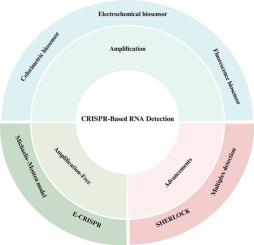The progress of CRISPR/Cas-based RNA detection
IF 4.9
2区 化学
Q1 CHEMISTRY, ANALYTICAL
引用次数: 0
Abstract
The discovery of microRNAs (miRNAs) in 1993 marked a crucial milestone in the field of molecular biology. Presently, they function as indispensable biomarkers for precision medicine, serving as regulators of gene expression. However, miRNAs are in very low abundance in body fluids, which challenges their precise detection. The clustered regularly interspaced short palindromic repeats (CRISPR)/CRISPR-associated (Cas)-based detection, as a cutting-edge technique, has become an immensely effective tool for molecular diagnosis owing to its outstanding advantages, such as high sensitivity, sequence-targeted single-base specificity, and rapid turnover time of cleavage. This paper conducts a comprehensive examination of the recent advancements in CRISPR/Cas-based RNA detection, which includes amplification-free and amplification-involved fluorescence biosensors, single-molecule platforms, and material-assisted biosensors. We emphasize technology advancements, evaluate performance indicators, and address problems in clinical translation, offering a framework for future research in precision diagnostics.

基于CRISPR/ cas的RNA检测技术进展
1993年microRNAs (miRNAs)的发现标志着分子生物学领域的一个重要里程碑。目前,它们作为基因表达的调节者,是精准医疗不可或缺的生物标志物。然而,mirna在体液中的丰度非常低,这给它们的精确检测带来了挑战。基于簇状规则间隔短回文重复序列(CRISPR)/CRISPR-associated (Cas)的检测技术作为一项前沿技术,以其高灵敏度、序列靶向的单碱基特异性和快速的切割周转期等突出优势,成为分子诊断的一种非常有效的工具。本文全面综述了基于CRISPR/ cas的RNA检测的最新进展,包括无扩增和涉及扩增的荧光生物传感器、单分子平台和材料辅助生物传感器。我们强调技术进步,评估绩效指标,并解决临床翻译中的问题,为未来的精确诊断研究提供框架。
本文章由计算机程序翻译,如有差异,请以英文原文为准。
求助全文
约1分钟内获得全文
求助全文
来源期刊

Microchemical Journal
化学-分析化学
CiteScore
8.70
自引率
8.30%
发文量
1131
审稿时长
1.9 months
期刊介绍:
The Microchemical Journal is a peer reviewed journal devoted to all aspects and phases of analytical chemistry and chemical analysis. The Microchemical Journal publishes articles which are at the forefront of modern analytical chemistry and cover innovations in the techniques to the finest possible limits. This includes fundamental aspects, instrumentation, new developments, innovative and novel methods and applications including environmental and clinical field.
Traditional classical analytical methods such as spectrophotometry and titrimetry as well as established instrumentation methods such as flame and graphite furnace atomic absorption spectrometry, gas chromatography, and modified glassy or carbon electrode electrochemical methods will be considered, provided they show significant improvements and novelty compared to the established methods.
 求助内容:
求助内容: 应助结果提醒方式:
应助结果提醒方式:


